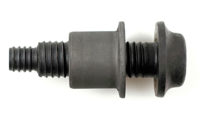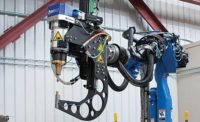For many decades, welding was considered the only way to ensure joint integrity in demanding load-bearing or high-vibration structures. So, companies manufacturing heavy-duty equipment or fabricating large, metal structures only welded joints.
Today, there is a fastener alternative to welding: direct-tension, swaged lockbolts. These two-piece fasteners are part bolt and part blind rivet. They consist of a short, non-threaded cylindrical collar and a long, headed pin that has both nonhelical threads and a pintail that breaks off during installation.
These fasteners are installed using a direct tension technique, in which the pin is pulled while the collar is simultaneously swaged into the locking grooves of the pin, deforming the collar into the grooves.
Lockbolts produce permanent joints with high clamp loads, stability and excellent resistance to vibration. Because the lockbolts’ installation process is faster and safer than welding, and does not require highly trained personnel, manufacturers are increasingly using them to assemble truck suspensions and chassis, railroad track crossings and heavy defense vehicles.
Welding Drawbacks
Over many years and millions of joints, welding has proven to be one of the surest processes for securing a joint. But, it does have several drawbacks. The welding process is time consuming, and it requires several costly and time-consuming quality control procedures. Welding also requires skilled, often highly paid, technicians, who, in industries such as oil and gas, are difficult to find and retain.
Another issue relating to welding is heat. The heat generated by welding can significantly reduce the strength of the metals being joined and damage critical surface coatings. In addition, welding dissimilar metals or pieces of varying sizes can be a challenge. Experienced welders also know that removing and reworking a weld can be problematic.
Finally, welding is dangerous and dirty. Safety is critical and must be practiced continually because a random spark can start a deadly fire. Equally important, spent rods and other remnants of the welding process must be handled properly to keep the work area and plant safe and clean.
Fastener Features and Benefits
Introduced during the mid-20th century, lockbolts are available in a wide range of pin diameters. Alcoa Fastening Systems offers HuckBolts with pin diameters from 0.1875 inch to 1.375 inches. The company also offers similar metric sizes.
Lockbolts are usually made from steel, stainless steel or titanium. However, they can also be made from aluminum because their nonhelical threads do not gall during installation. When a material galls, some of it is pulled by the contacting surface. Helical threads on conventional fasteners often gall during run-down.
Pins can be made with round, brazier, truss, mushroom or countersunk heads. Collars come with or without flanges. Both components can be coated or plated to prevent corrosion.
The main benefit of a lockbolt is its long-term resistance to the effects of vibration. In a conventional bolted joint, there are always gaps between the threads of the nut and bolt. These spaces cause loosening in high-vibration applications. In contrast, an installed lockbolt has no gaps because the collar is fully swaged into the shallow locking grooves of the pin. These shallow grooves produce high joint strength—up to five times that of a conventional nut and bolt.
Other benefits include high shear and tensile strength. Data from Junkers tests—a standard procedure that exposes fastened joints to transverse vibrations—indicate that lockbolts maintain consistent clamp load over time, without requiring secondary devices such as lock washers, wires or threadlocking compounds.
Most lockbolts, including HuckBolts made by Alcoa Fastening Systems, can also be used with virtually any metal. Dissimilar metals with dissimilar coefficients of thermal expansion present no problems. Varying piece sizes in a joint are readily accommodated, and surface finishes are not harmed.
The BobTail HuckBolt is Alcoa’s latest lockbolt. It features gripper threads rather than a pintail. This design offers end-users two important benefits.
First, the BobTail weighs 40 percent less than standard lockbolts and requires that much less force for installation. For example, a 0.625-inch-diameter BobTail requires a 10-pound tool, whereas a similar-size standard lockbolt requires a nearly 20-pound tool.
This lower force produces a jolt-free swaging action, reducing operator fatigue and repetitive stress syndrome. It also makes installation quieter.
Second, the gripper threads stay on during installation. This eliminates a possible initiation point for corrosion, as well as the need for material clean-up.
The fastener also has a specially designed collar with bumps along the flange. When the collar is fully swaged, the bumps crease, providing operators with a visual cue that the fastener is installed correctly.
Lockbolt performance parameters depend on fastener diameter and material. For instance, a 0.1875-inch-diameter Grade 5 carbon steel BobTail delivers 1,200 pounds of clamp load, 2,200 pounds of tensile strength, and 2,430 pounds of shear strength. By contrast, an aluminum version of this same lockbolt delivers 550, 1,000 and 1,050 pounds, respectively.
Similarly, a 0.375-inch-diameter BobTail delivers 5,980 pounds of clamp load, 9,300 pounds of tensile strength, and 9,600 pounds of shear strength. The aluminum version provides 2,200 pounds, 4,200 pounds and 4,200 pounds, respectively.
Installation: Quick and Easy
Standard and BobTail Lockbolts are installed using a direct tension technique. The pin of the standard lockbolt is inserted into a prepared hole, the collar is spun onto the pin, and the installation tool is placed over the grooves on the pin. When the tool is activated, a puller in its nose assembly draws the pin into the tool, causing the swaging anvil to press on the collar and draw up any sheet gap.
At a predetermined force, the anvil begins to swage the collar into the pin’s lock grooves. Continued swaging elongates the collar and pin to produce a precise clamp load. When swaging of the collar into the pin lock grooves is complete, the tool pulls on the pintail and snaps it. This completes installation. With the BobTail, once swaging is completed, the tool releases off the fastener.
A typical lockbolt (0.625-inch-diameter Grade 8 fastener) can be installed in as little as 2 seconds, not counting the time it takes to drill a hole. Cycle time is short because the tool grabs the pin very quickly.
Once the operator engages the trigger, the swage and eject sequence is programmed to complete the cycle without any additional installer input. A quick visual inspection is all that is required to confirm the fastener is properly installed.
In addition, an operator requires minimal training to proficiently install lockbolts—making the use of lockbolt fasteners a cost-effective assembly process.
Lockbolt installation tools are hydropneumatic or hydraulic. Hydropneumatic (also termed as pneudraulic) tools are best for lockbolts less than 0.5 inch in diameter; hydraulic tools are necessary for larger-diameter fasteners. Each tool is versatile enough to install fasteners of various diameters. However, the nosepiece of the tool does need to be changed to match each fastener’s diameter.
Tools are usually operated manually, but semiautomatic workcells also are in operation. In these applications, 0.1875- to 0.25-inch-diameter lockbolts are being installed. The operator manually loads the parts and inserts the pins and collars. Then, with the press of a button, multiple tools mounted on linear actuators simultaneously grab the pins and collars, and swage all of the collars to the pins.
Lockbolts do have one major drawback, though. After installation, a section of the pin remains and protrudes above the collar. For applications where the protrusion cannot be accommodated, manufacturers may be forced to use conventional welding.





